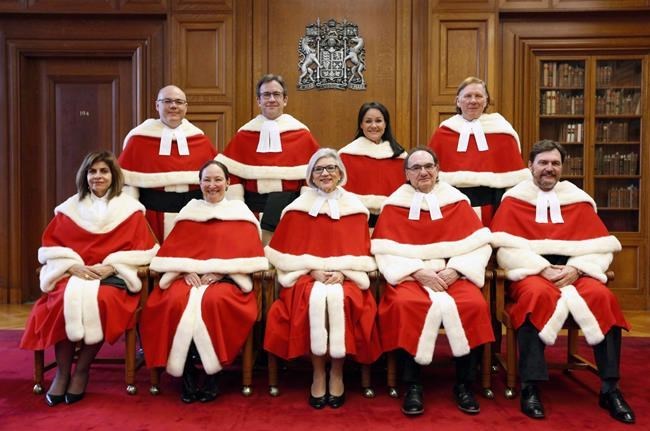
The Supreme Court Justices pose for a group photo during the official welcoming ceremony for Justice Malcolm Rowe, in Ottawa, Friday, December 2, 2016. Top row, left to right, Justice Russell Brown, Justice Clement Gascon, Justice Suzanne Cote, and Justice Malcolm Rowe. Bottom row, left to right, Justice Andromache Karakatsanis, Justice Rosalie Abella, Chief Justice Beverley McLachlin, Justice Michael Moldaver, Justice Richard Wagner. Prime Minister Justin Trudeau has made his second appointment to the Supreme Court of Canada, naming Sheilah Martin to fill the vacancy that will open when Chief Justice Beverley McLachlin retires next month. THE CANADIAN PRESS/Fred Chartrand
November 29, 2017 - 10:19 AM
OTTAWA - Prime Minister Justin Trudeau has made his second appointment to the Supreme Court of Canada, naming Sheilah Martin to fill the vacancy that will open when Chief Justice Beverley McLachlin retires next month.
Martin joins a unique body, the final court of appeal for the country.
The nine justices of the Supreme Court sit at the top of the country's legal system, hearing appeals from the decisions of the provincial and territorial courts of final resort, as well as from the Federal Court of Appeal and the Court Martial Appeal Court of Canada.
Here's a look at its members:
Chief Justice Beverley McLachlin has been a member of the court for 28 years and chief for almost 18 years. She is the first woman to hold the top spot and is also the country's longest-serving chief justice. In 1989, she was named to the Supreme Court of Canada by then-prime minister Brian Mulroney. She was raised to chief justice by then-prime minister Jean Chretien in 2000. She led the court through landmark interpretations of the Charter of Rights and Freedoms.
___
Justice Rosalie Abella was born in a displaced persons camp in Germany in 1946. Her family came to Canada in 1950 as refugees. She earned her law degree from the University of Toronto in 1970 and in 1976 was appointed to the Ontario family court at the age of 29, the youngest and the first pregnant person appointed to the judiciary in Canada. In 2004, then-prime minister Paul Martin named her to the Supreme Court. She is the first Jewish woman justice.
___
Justice Michael Moldaver grew up in Peterborough, Ont., and attended the University of Toronto, where he earned a law degree in 1971. From 1978 to 1995, he co-taught criminal law courses at Osgoode Hall Law School and at the University of Toronto. He was appointed to the Supreme Court of Ontario, later the Ontario Court of Justice (General Division) in 1990. In 1995, he was elevated to the Ontario Court of Appeal. He was named to the Supreme Court in 2011 by then-prime minister Stephen Harper.
___
Justice Andromache Karakatsanis earned her law degree at the University of Toronto and was called to the bar in 1982. She served as Ontario cabinet secretary, the province's senior public servant, from 2000 to 2002, when she was named to the Ontario Superior Court of Justice. She was raised to the Ontario Court of Appeal in 2010 and appointed to the Supreme Court by Harper in 2011.
___
Justice Richard Wagner was born in Montreal and earned a law degree from the University of Ottawa in 1979. He practised law for more than 20 years, focusing on professional liability and on commercial litigation related in particular to real estate law, oppression remedies and class action suits. As a Quebec Superior Court judge, he sat on several of the court’s committees, including the judicial practice committee for training of newly appointed judges. He was named to the Supreme Court by Harper in 2012.
___
Justice Clement Gascon earned a law degree at McGill University in 1981. He practised law for 21 years at Heenan Blaikie in Montreal, working primarily in civil and commercial litigation and in labour law. From 2007 to 2012, he co-chaired the judgment writing seminar of the Canadian Institute for the Administration of Justice. He was appointed to the Quebec Court of Appeal in 2012 and was named to the Supreme Court by Harper in 2014.
___
Justice Suzanne Cote studied law at Laval University before being called to the Quebec Bar in 1981. She worked with major Montreal law firms after starting her practice in the Gaspe, where she was born. She was noted as a top litigator by her peers. She was appointed to the Supreme Court by Harper in 2014.
___
Justice Russell Brown earned his BA at the University of British Columbia and received a law degree from University of Victoria in 1994. He practised law in British Columbia and taught law at the University of Alberta from 2004 to 2013. He has published law review articles, book chapters and review essays on tort law, property law and civil justice. He was appointed to the Supreme Court by Harper in 2015.
___
Justice Malcolm Rowe studied at Memorial University in St. John's, N.L., and earned a law degree from Osgoode Hall in Toronto. In 1980, he joined what was then the Department of External Affairs as a foreign service officer. In 1984, he joined an Ottawa law firm and worked on disputes over Canada’s Atlantic maritime boundaries and overfishing on the Grand Banks of Newfoundland. Trudeau appointed him to the Supreme Court in 2016.
News from © The Canadian Press, 2017